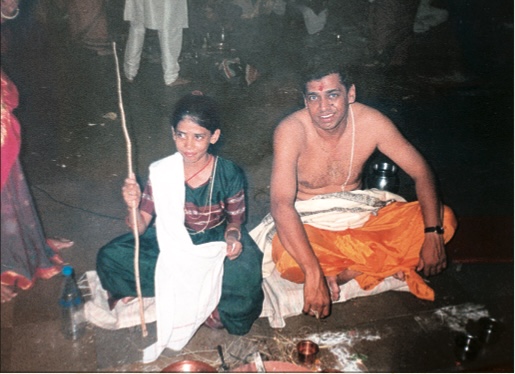Ten young brahmin girls received their upanayana, or thread ceremony, commencing the study of the Vedas, on April 2, 2000. Normally this rite of passage is only for boys and not allowed for girls. This was the first ceremony of its kind for girls in Pune, India. The followers of Shankar Seva Samiti organized it with Vedamurti Karmabalekar Shastri as the officiating priest. The girls came with their parents and were initiated into the Gayatri Mantra by their fathers. Many orthodox Hindus are against this concept, but the women priests showed them ample literary references to women’s thread ceremonies and Vedic study in the ancient Vedic culture.
It was about 25 years ago, in the Ahmednagar district, that the Shanker Seva Samiti organization began teaching women the Vedas as well as training them as priests. Now around 10,000 women are qualified priests. Many are even more popular in the community than their male counterparts because of their enthusiasm, concentration and devotion in doing worship.
In all four Vedas, there are references to women ascetics reciting Vedic hymns and even creating mantras. The names of Apala, Ghosha, Shashwati and Indrani are popular in the Vedas. In the Upanishads, Gargi and Maitraiyee are famous women ascetics. The Rig Veda (10.109.4) says, “When a brahmin’s wife wears the auspicious thread, she becomes very popular.”
Other scriptures also mention women wearing the sacred thread. In the Harit Smriti it says, “Brahmin women have the right to a sacred thread ceremony, a fire ceremony, the study of Vedas and a right to sacred begging.” The Yama Smriti says, “Performing the thread ceremony for young girls, studying Vedas and recitation of Gayatri Mantra was allowed in ancient times.”
Paraskar Grihya Sutra (4th-5th century) states, “Those females who have undergone the thread ceremony and those who have not should sleep on their left side with their heads towards the east.”
P.V. Kane, in the History of Dharmasastra, afforded this topic three-and-a-half pages. Writes Kane: “An interesting question is whether women ever had upanayana performed, or whether they had to wear the sacred thread. Harita Dharmasutra, as quoted in the Smriti-candrika, says, ‘There are two sorts of women. Those who are bramavadinis (students of sacred lore) and those that are sadyovadhus (who marry straightaway). Out of these, brahmavadinis have to go through upanayana, keeping fire, Vedic study and begging in one’s house (under the parents’ roof). But in the case of sadyovadhus, when their marriage is drawing near, the mere ceremony of upanayana should somehow be performed and then their marriage should be celebrated. Therefore bramavadini women had upanayana performed in the eighth year from conception, then studied Vedic lore and finished student-hood at the age of puberty.’ ”
Kane continues, “Yama smriti says, ‘In former ages, tying of the sacred thread was desired in the case of maidens. They were taught the Vedas and made to recite the sacred Gayatri verse.'” Kane also indicates that Manusmriti, confirmed the performance of upanayana for girls but hinted to its going out of practice.
Though too many neglect their duties, this initiation indicates a growing interest and that a significant number faithfully follow their disciplines. The future sucess of the girls’ as well as boys’ upanayana depends on how well they study the Vedas and follow their disciplines.
V.L. Manjul, e-mail:vasudeomanjul@hotmail.com


